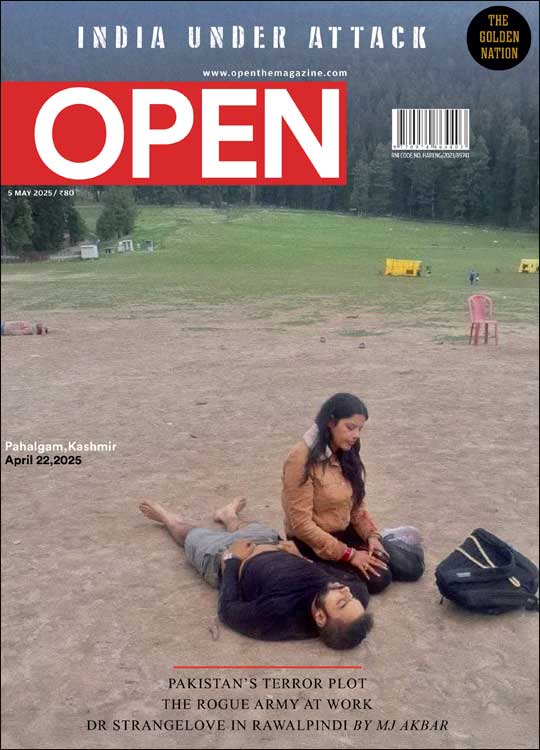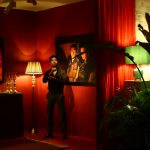Production Designers: Scene Sealers
They give form to a filmmaker’s vision, yet they toil in relative anonymity. The production designers of Bollywood have proved their genius in recent films
 Mohini Chaudhuri
Mohini Chaudhuri
 Mohini Chaudhuri
Mohini Chaudhuri
 |
09 Mar, 2016
|
09 Mar, 2016
/wp-content/uploads/2016/03/Art-Director-1-a.jpg)
EVER NOTICED the colour of the flowers in Kashibai’s room in Bajirao Mastani? Or the little statue of Job Charnock, the East India Company administrator of Calcutta, in Detective Byomkesh Bakshy!? Probably not. To be fair, these details appear only fleetingly on screen, and yet, they are vital in creating the atmosphere of a film. The people behind such worlds are production designers.They get down to work soon as the screenplay and dialogues are locked, breathing life into the written word. By definition, production designers create the entire look for a film, the colour tones and make-up, the costumes and sets. By combining the technical with the creative, they give form to the director’s vision and meat and bones to the script.
Though their role is vital to cinema, the production designers of Bollywood toil in near anonymity. In a film-crazy country, we know actors and directors, producers and filmmakers, but the technicians are all but invisible. Of late, with a slew of major releases based on historic events, the role of the production designer is coming to the fore, and is gaining long-deserved attention.
A recent film where the brilliance of the production design was obvious for all to see was Neerja, where Aparna Sud built the entire aeroplane on which the hijacking drama was shot. Another example would be Sujeet Sawant and Sriram Iyengar’s majestic and opulent sets of Bajirao Mastani, which at times stole attention away from the leading lady played by Deepika Padukone.
These designers have been working in the film business for a while now, but accolades have come their way only recently. “I’ve worked on 22 films. In the last year I worked on ABCD2 and Tevar. But none of them has taken off the way Neerja has. I’m flooded with congratulatory calls and messages like never before,” says Sud.
We shot Pinga at night in an open-air set and used diyas and torches to light up the background. Each time a diya snuffed out, we had to stop the shoot and light it again. – SUJEET SAWANT, production designer, Bajirao Mastani
For Sawant and Iyengar, working on Bajirao Mastani was a dream that took over a decade to be realised. Back in 2002, when both were assistant art directors on Sanjay Leela Bhansali’s Devdas, they heard murmurs of the auteur’s passion project titled Bajirao Mastani. After a peek at the script, they began researching the period drama on their own. A few months later, the project was canned. By then Sawant and Iyengar had waded too deep in Maratha history to let it go. They decided to prepare a presentation, which would double-up as a portfolio while hunting for employment.
After 13 years and numerous failed attempts to get the script off the ground, Bhansali finally found his Bajirao and Mastani in Ranveer Singh and Padukone. He also found an art director with whom things didn’t materialise. In walked Sawant and Iyengar with a ready-made plan that they had honed over the years. “In two months we were shooting. Thank God we had a presentation that was already prepared. We went to Pune and Satara to visit the ruins of Maratha homes. We found a wada (a traditional Maharashtrian residential colony) that we used as a reference to plan for the Shaniwar wada (seat of Peshwa rulers) in the film,” says Sawant.
Research and attention to detail form the backbone of a production designer’s work. However, when the project is a period film or based on a real event, factual errors can crop up. Mustafa Stationwala, production designer on Airlift (inspired from an incident that took place during the 1990 Iraq-Kuwait war) says no one from the film unit was granted a visa to Kuwait for a recce. Even worse, there were barely a handful of photos of Kuwait streets on Google. The film was eventually shot in Ras al-Khaimah in the UAE. “We didn’t have any visual references. Our data came from talking to people who have lived there and studying photos of Saudi Arabia. We assumed Kuwait would be similar. But when we showed the film to a few people, they pointed out small things—such as a street sign that was correct but the typography was wrong. I realised that everything in the frame is being seen,” says Stationwala.
My job is not to glamourise the film. Storytelling is not greater than my art. I try to keep my frames down to earth and real.” – MUSTAFA STATIONWALA, production designer, Airlift
His brother—one of the Indians to be evacuated from Kuwait during the 1990 exodus—was his main source of information. Funnily, many crucial props—like the landline phone Akshay Kumar uses in the film and old milk cartons—came from families in Stationwala’s hometown in Ratlam, Madhya Pradesh. The hardest items to source were the cars shown on the war-torn streets and an old model of a Casio diary that was eventually found in Mumbai’s Chor Bazaar after a 15-day hunt. “In the 90s, most people were using Toyotas. But the ones we found were white and no one in that part of the world buys cars in that colour. They are into bright and glossy colours. So we bought 78 cars and painted them. Every night we burnt the exterior and painted them again for another scene. In 20 days we must have painted them at least five times so that it looked like we had 35 cars. Most of them were sourced from junkyards,” says Stationwala.
Similarly, Vandana Kataria became an expert on 40s Bengal before she designed the look for Dibakar Banerjee’s Detective Byomkesh Bakshy! The film got a lukewarm response, but each frame of the dark thriller was painstakingly crafted by the National School of Design graduate. Her research included trawling through Bengali literature, movies, archives, and visiting families to record an oral history of old Calcutta. Her major point of reference was old photo albums that some families agreed to share.
It’s safe to say that Bollywood hasn’t always been a stickler for factual accuracy. If things are changing today, it’s because the audience is more discerning, and more filmmakers are favouring realism.
Ram Madhvani’s Neerja was shot on a constructed plane, identical to the actual aircraft except for a missing engine. Sud, who had never taken on a project of this magnitude before, says that she knew building a replica of the hijacked Pan Am flight in a mere 48 days would be a once-in-a-lifetime opportunity that she couldn’t refuse. “I got a pilot to come on board as a consultant while we were constructing it. He kept saying, ‘What you’re doing is bizarre. It’s never going to happen,’” she recalls. The aircraft was created in an empty maidan in Borivali West and propped up to an altitude of 22 feet. “There were a lot of glitches. In the middle the shape of the aircraft got totally out of control and started looking like a whale. We lost a couple of days trying to fix that,” she says, adding that her main concern was making the structure sturdy enough to accommodate six cameras and a film crew of 250.
Short of being air worthy, Sud’s final version of the plane was as authentic as a real one. The intercoms, washrooms, overhead cabins were all in working condition. The tiny sign in the galley buffet was exactly as on Pan Am flights. Even the speedometer readings in the cockpit were accurate. The taps had water flowing and the seats could be reclined. “The only change we made was the space between the seats so that we could fit a camera, and the colour of the plane. The original Pan Am plane had an orange shade, but we changed it to blue and grey, keeping in mind the mood of the film,” Sud adds.
“I got a pilot to come on board as a consultant while we were constructing the aeroplane. He kept saying, ‘What you’re doing is bizarre. It’s never going to happen.” APARNA SUD, production designer, Neerja
Constructing the 22 sets of Bajirao Mastani was no less of a production nightmare. The Aaina Mahal in the film required 4,500 wooden planks and 100 workers a day; the Shaniwar wada took 45,000 plans and 600 workers a day. And the song Pinga, a dance-off between Deepika Padukone and Priyanka Chopra, turned out to be a true test of patience and resolve. “We shot the song at night in an open-air set and used diyas and torches to light up the background. Each time a diya snuffed out, we had to stop the shoot and light it. Sanjay sir is very particular and would refuse to use VFX (visual effects) in post production to cover up these tiny things,” says Sawant. “We had 12 people running around the set with candles and oil. Every time someone spilt something, we had to immediately clean it up. We couldn’t risk anything with superstars dancing there. By the end of it, we had used ridiculous amounts of oil and wicks. We kept sending people out to bring gunny bags of diyas,” adds Iyengar.
The trade-off of working with a perfectionist and often temperamental filmmaker like Bhansali, they say, is that he relishes opulence and grandeur in films. When he liked a prop they had created, he would choreograph the scene so that it was prominent in the frame.
In Bollywood, confusion persists around the role of the production designer. In the West, this professional is a key member of the team that overlooks several other visual departments. Here, the job isn’t so well-defined and is often confused with the role of an art director. In many cases, the people credited with the title of ‘production designer’ supervise only sets and don’t have a say in costume or make-up. That apart, viewers don’t know what they do, especially if it is a film that isn’t opulent. Both Sawant and Iyengar have also worked on films like Onir’s I Am (2010), where the tone was more sedate, and they found that equally challenging.
Stationwala, who primarily works on ad films, says he takes up feature film projects only when the subjects are believable. “My job is not to glamourise the film. Storytelling is not greater than my art. I try to keep my frames down to earth and real,” he says. For Airlift, he designed each set after carefully studying the back story of all the characters. “Ranjit Katyal (Kumar’s character) had a lot of gold and shiny things in his home. From the way I looked at it, he was someone who spent most of his time with Arabs so he had imbibed their taste. Also, if you look closely there are three Filmfare trophies lying in his house. According to me, his wife was a film actress who did just a few films, got noticed by a rich businessman, and settled abroad,” he adds.
Is it frustrating that their efforts are often overlooked, that their own families often find it hard to understand their work? Sud says that when a set is so real and mundane that nobody recognises the labour behind it, it’s an achievement. “I built one of my most favourite sets for my first film, Ram Gopal Varma’s Shiva in 2006. I had made an Iranian café in an open space in Andheri. I tried to replicate the popular Irani café Kayani in South Bombay. After it was done, people started walking in and asking for tea. I knew that was the sign of a good set,” says Sud. But, every now and then, she finds herself having to explain the importance of her job. “This question, ‘parr tune kya kiya?’ is what I hear most often,” she says, with a laugh. Stationwala recalls getting a snarky text message from someone in the industry after his film NH10 released that, in effect, had the same query. “But it’s okay,” he says, “This is a part of my job.”

/wp-content/uploads/2025/04/ToC-Cover-Pahalgam.jpg)













More Columns
Ex-Pak commando ‘Musa’ behind the Pahalgam massacre Open
Caught Mid-Air: The Horror Beneath a Tourist’s Zipline Ride V Shoba
Does ‘obscenity’ on OTT and social media platforms need regulation? Lhendup G Bhutia